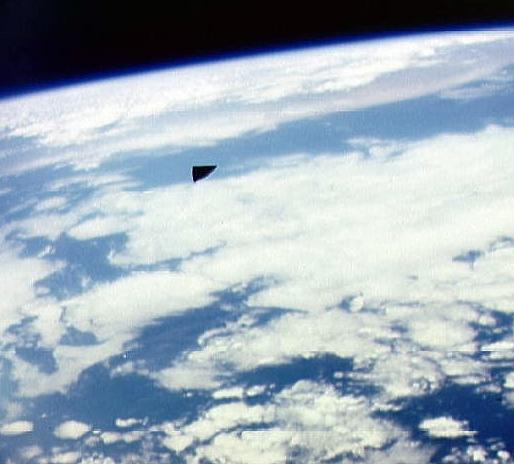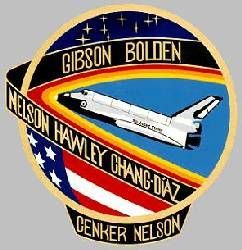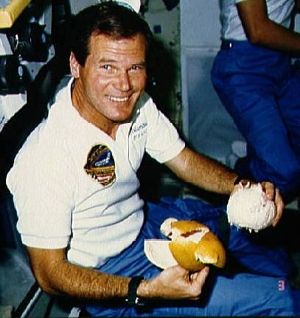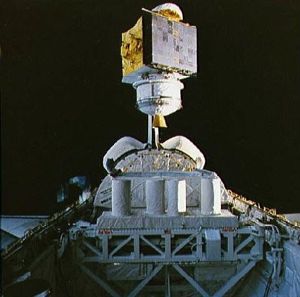
Home - Search - Browse - Alphabetic Index: 0- 1- 2- 3- 4- 5- 6- 7- 8- 9
A- B- C- D- E- F- G- H- I- J- K- L- M- N- O- P- Q- R- S- T- U- V- W- X- Y- Z
STS-61-C

STS-61-C
Piece of thermal insulation tile floats near the Shuttle Columbia
Credit: NASA
AKA: Columbia. Launched: 1986-01-12. Returned: 1986-01-18. Number crew: 7 . Duration: 6.09 days.
Payloads: Deploy SATCOM (RCA-Satellite Communications) Ku-1 with Payload Assist Module (PAM)-D II. Materials Science Laboratory, Comet Halley Active Monitoring Experiment (CHAMP), Hitchhiker (HH) Goddard (G)-1, thirteen getaway specials (GAS), student experiment, Initial Blood Storage Equipment (IBSE), Characterization of Space Motion Sickness (SMS).
Orbits of Earth: 97. Distance traveled: 4,069,480 km. Orbiter Liftoff Mass: 116,121 kg. Orbiter Mass at Landing: 95,325 kg. Payload to Orbit: 14,724 kg. Payload Returned: 9,122 kg. Landed at: Concrete runway 22 at Edwards Air Force Base, Cali. Landing Speed: 402 kph. Touchdown miss distance: 464 m. Landing Rollout: 3,109 m.
NASA Official Mission Narrative
Mission Name: 61-C (24)
COLUMBIA (7)
Pad 39-A (36)
24th Shuttle mission
7th Flight OV-102
RSLS Abort (3)
Extended mission
Diverted landing
2nd Night landing
Crew:
Robert L. Gibson (2), Commander
Charles F. Bolden (1), Jr., Pilot
Franklin R. Chang-Diaz (1), Mission Specialist 1
Steven A. Hawley (2), Mission Specialist 1
George D. Nelson (2), Mission Specialist 2
Robert J. Cenker (1), Payload Specialist 1
Congressman Bill Nelson (1), Payload Specialist 2
Milestones:
OPF - July 18, 1985
VAB - Sept.6, 1985
(storage)
OPF - Sept. 26, 1985
VAB - Nov. 22, 1985
PAD - Dec. 2, 1985
Payload:
SATCOM-KU2,LEASAT-5,MSL-2,CHAMP,IR-IE,SSIP(x3),GAS(x13)
Mission Objectives:
Launch:
January 12, 1986, 6:55:00 a.m. EST. Launch set for Dec. 18, 1985 delayed one day when additional time needed to close out orbiter aft compartment. Launch attempt Dec. 19 scrubbed at T- 14 seconds due to indication that right solid rocket booster hydraulic power unit exceeding RPM redline speed limits. (Later determined as false reading.) After 18-day delay, launch attempt Jan. 6, 1986 halted at T-31 seconds due to accidental draining of approximately 4,000 pounds of liquid oxygen from external tank. Launch attempt Jan. 7 scrubbed at T-9 minutes due to bad weather at both transoceanic abort landing sites (Moron, Spain and Dakar, Senegal). After two-day delay, launch set for Jan. 9 delayed due to launch pad liquid oxygen sensor breaking off and lodging in number two main engine prevalve. Launch set for Jan. 10 delayed two days due to heavy rains. Launch countdown Jan. 12 proceeded with no delays. Launch Weight: 256,003 lbs.
Orbit:
Altitude: 212nm
Inclination: 28.5 degrees
Orbits: 98
Duration: Six days, two hours, three minutes, 51 seconds.
Distance: 2,528,658 miles
Hardware:
SRB: BI-024
SRM: L024(HPM)
ET : 30/LWT-23
MLP : 1
SSME-1: SN-2015
SSME-2: SN-2018
SSME-3: SN-2109
Landing:
January 18,1986, 5:58:51 a.m, PST, Runway 22, Edwards Air Force Base, Calif. Rollout distance: 10,202 feet. Rollout time: 59 seconds. Planned landing at KSC, originally scheduled for Jan. 17, moved to Jan. 16 to save orbiter turnaround time. Landing attempts on Jan. 16 and 17 abandoned due to unacceptable weather at KSC. Landing set for Jan. 18 at KSC but persisting bad weather forced a one revolution extension of mission and landing at Edwards. Orbiter returned to KSC Jan. 23, 1986. Landing Weight: 210,161 lbs.
Mission Highlights:
SATCOM KU-I (RCA Americom) satellite, attached to Payload Assist Module-D2 (PAM-D2) motor, was deployed. Comet Halley Active Monitoring Program (CHAMP) experiment, a 35mm camera to photograph Comet Halley, did not function properly due to battery problems. Other payloads: Materials Science Laboratory-2 (MSL-2); Hitchhiker G-1; Infrared Imaging Experiment (IR-IE); Initial Blood Storage Experiment (IBSE); Hand-held Protein Crystal Growth (HPCG) experiment; three Shuttle Student Involvement Program (SSIP) experiments and 13 Get Away Specials (GAS), 12 of them mounted on a special GAS Bridge Assembly.
More at: STS-61-C.
Family: Manned spaceflight. People: Bolden, Cenker, Chang-Diaz, Gibson, Hawley, Nelson, Nelson, Bill. Country: USA. Spacecraft: Columbia. Projects: STS. Launch Sites: Cape Canaveral. Agency: NASA, NASA Houston. Bibliography: 4457.
 | STS-61-C Credit: www.spacefacts.de |
 | STS-61-C Representative Bill Nelson prepares to eat a peeled grapefruit Credit: NASA |
 | STS-61-C Astronaut Charles Bolden in pilots station prior to entry Credit: NASA |
 | STS-61-C Astronaut Franklin Chang-Diaz checking payload bay through aft deck window Credit: NASA |
 | STS-61-C Four STS 61-C crewmembers gather at the commander's station Credit: NASA |
 | STS-61-C The SATCOM Ku-1 communications satellite deployed from Columbia Credit: NASA |
 | STS-61-C Night landing of Shuttle Columbia at Edwards AFB and end of STS 61-C mission Credit: NASA |
1986 January 12 - .
- STS-61-C - Wakeup Song: Monty Python's Flying Circus - . Flight: STS-61-C. "Monty Python's Flying Circus" TV show ("Liberty Bell March" by John Philip Sousa) . CAPCOM: Shannon Lucid.
1986 January 12 - . 11:55 GMT - . Launch Site: Cape Canaveral. Launch Complex: Cape Canaveral LC39A. Launch Platform: MLP1. LV Family: Shuttle. Launch Vehicle: Space Shuttle.
- STS-61-C - .
Call Sign: Columbia. Crew: Bolden,
Cenker,
Chang-Diaz,
Gibson,
Hawley,
Nelson,
Nelson, Bill.
Payload: Columbia F07 Satcom-K 1 [PAM-D2]. Mass: 14,724 kg (32,460 lb). Nation: USA.
Related Persons: Bolden,
Cenker,
Chang-Diaz,
Gibson,
Hawley,
Nelson,
Nelson, Bill.
Agency: NASA Houston.
Program: STS.
Class: Manned.
Type: Manned spaceplane. Flight: STS-61-C.
Spacecraft Bus: Shuttle.
Spacecraft: Columbia.
Duration: 6.09 days. Decay Date: 1986-01-18 . USAF Sat Cat: 16481 . COSPAR: 1986-003A. Apogee: 338 km (210 mi). Perigee: 331 km (205 mi). Inclination: 28.50 deg. Period: 91.20 min.
Manned seven crew. Launched Satcom K1. Payloads: Deploy SATCOM (RCA-Satellite Communi-cations) Ku-1 with Payload Assist Module (PAM)-D II. Materials Science Laboratory, Comet Halley Active Monitoring Experiment (CHAMP), Hitchhiker (HH) Goddard (G)-1, thirteen getaway specials (GAS), student experiment, Initial Blood Storage Equipment (lBSE), Characterization of Space Motion Sickness (SMS).
1986 January 14 - .
- STS-61-C - Wakeup Song: Heart of Gold - . Flight: STS-61-C. "Heart of Gold" by Neil Young.
1986 January 18 - .
- STS-61-C - Wakeup Song: Stars and Stripes Forever - . Flight: STS-61-C. "Stars and Stripes Forever".
1986 January 18 - .
- Landing of STS-61-C - . Return Crew: Bolden, Cenker, Chang-Diaz, Gibson, Hawley, Nelson, Nelson, Bill. Nation: USA. Related Persons: Bolden, Cenker, Chang-Diaz, Gibson, Hawley, Nelson, Nelson, Bill. Program: STS. Flight: STS-61-C. STS-61-C landed at 13:59 GMT. .
Back to top of page
Home - Search - Browse - Alphabetic Index: 0- 1- 2- 3- 4- 5- 6- 7- 8- 9
A- B- C- D- E- F- G- H- I- J- K- L- M- N- O- P- Q- R- S- T- U- V- W- X- Y- Z
© 1997-2019 Mark Wade - Contact
© / Conditions for Use